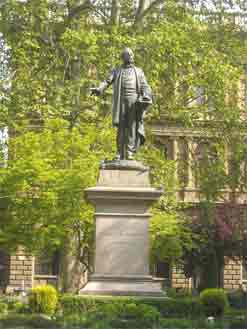"The names of the Risorgimento are alive, they are within
us, they belong to us", said Carlo Azeglio Ciampi, but maybe it is not
quite like that, at least in relation to our daily experience, when we
remain down to earth. We are at a loss with the street names of our city
and that is actually something we should ponder over.
Bologna has
dedicated to men of thought or action of the Risorgimento period numerous
squares and streets, large or small, essentially in the historical centre
and these are impossible to ignore. It is with certainty that in front of
the monument dedicated to Marco Minghetti, or the one to Camillo Benso di
Cavour, or the equestrian statue of Giuseppe Garibaldi, there can be no
doubts: we are sure that these protagonists had a role to play in the
unification of Italy.
But, what did Luigi Carlo Farini do? And why is
Antonio Zanolini remembered? Giovanni Livraghi whose name was given to a
street, however small, near the D'Accursion Palace, what did he have to do
with the Risorgimento? He died with Ugo Bassi, but surely Ugo Bassi, who
stands with his arm outstretched with a patriotic and rebellious finger on
the street bearing his name, is a recognizable presence loved by the
Bolognese people. However his whole story is probably unknowm to most. So
are figures like Ernesto Masi or Angelo Masini. Their stories are vague
for most people.
To dust our memory a little, here is a summary
(however incomplete) of a few names (very synthetic as are the news; and
decidedly "school-like" in its presentation) of men linked to the birth of
Bologna, who lived during the Risorgimento and of whom Bologna's toponomy
is a reminder: Augusto Aglebert (1810-1882) participated in the uprisings
of 1831, in the defense of Venice and that of the Roman Republic; after
1859, he was the Archiginnasio library inspector.
Antonio Alessandrini (1786-1861), physician,
university professor, he took part in the Roman Republic as President of
the city; he was a member of the Romagna assembly.
Rodolfo Audinot
(1814-1874) participated in the uprisings of 1831, he was a deputy in the
1849 Roman constituent, deputy from 1860 and senator
of the Kingdom
from 1870.
Carlo Berti Pichat (1800-1878), agronomist, participated in
the uprisings of 1831, in the defense of Venice and that of the Roman
Republic; deputy and senator; councillor of the Municipality of Bologna
with functions as mayor in 1872.
Cesare Boldrini (1785-1849) fought
with Napoleon and in the first war of Independence; he died fighting
against the Austrians defending Bologna.
Camillo Casarini (1830-1874),
lawyer, patriot, deputy; mayor of Bologna from 1870 to
1872.
Giambattista Ercolani (1817-1883), veterinarian, university
professor, patriot, deputy, community and provincial counsellor of
Bologna.
Angelo Masini (1815-1849) participated in the uprisings of
1831 and in the fights of August 1848 in Bologna; he died defending the
Roman Republic.
Carlo Pepoli (1796-1881), author and poet, he fought in
the uprisings of 1831; he went into exile in England; deputy in the
Parliament of the Kingdom; then senator and minister; mayor of Bologna
from 1862 to 1866.
Antonio Silvani (1773-1847), jurist, he participated
in the uprisings of 1831; emprisoned in Venice, he went into exile in
Paris.
Federico Venturini (1813-1873), lawyer and patriot; he
participated in the uprisings of 1848 and defended the Roman Republic; he
died in Venice.
Luigi Zamboni (1772-1795), law student, in 1794 he put
into action what is considered the first insurrectionary attempt in Italy;
escaping with his friend De Rolandis, he was arrested and was defended
during his trial by lawyer Antonio Aldini, on August 18th, 1795 he was
found dead by choking in his cell.

And Gaetano Bottrigari? And Paolo Bovi Campeggi? And
Quirico Filopanti (that is to say Giuseppe Barilli), Giuseppe Gabusi,
Giovanni Gozzadini, Alessandro Guidotti, Pietro Inviti, Ernesto Masi,
Pasquale Muratori, Giuseppe Petroni, Pietro Pietramellara, Leopoldo Serra,
Luigi Tanari, Giovanni Vicini, Antonio Zanolini?
The history of Italy's
unification also involves these names, which today are found on street
signs, without awakening in us any particular souvenir or emotion as we
read them absent-mindedly.
Celebrating the 150th anniversity of the
unification of Italy could therefore be an opportunity to learn more on
these individuals and on the many others who are not as famous but are
part of the history of our nation.
